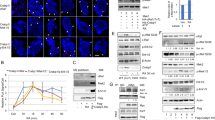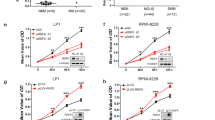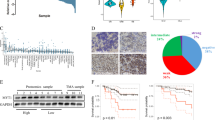Abstract
Cyclin A1 is essential for leukemia progression, and its expression is tightly regulated by acinus, a nuclear speckle protein. However, the molecular mechanism of how acinus mediates cyclin A1 expression remains elusive. Here we show that transcription corepressor CtBP2 directly binds acinus, which is regulated by nerve growth factor (NGF), inhibiting its stimulatory effect on cyclin A1, but not cyclin A2, expression in leukemia. NGF, a cognate ligand for the neurotrophic receptor TrkA, promotes the interaction between CtBP2 and acinus through triggering acinus phosphorylation by Akt. Overexpression of CtBP2 diminishes cyclin A1 transcription, whereas depletion of CtBP2 abolishes NGF's suppressive effect on cyclin A1 expression. Strikingly, gambogic amide, a newly identified TrkA agonist, potently represses cyclin A1 expression, thus blocking K562 cell proliferation. Moreover, gambogic amide ameliorates the leukemia progression in K562 cells inoculated nude mice. Hence, NGF downregulates cyclin A1 expression through escalating CtBP2/acinus complex formation, and gambogic amide might be useful for human leukemia treatment.
This is a preview of subscription content, access via your institution
Access options
Subscribe to this journal
Receive 50 print issues and online access
$259.00 per year
only $5.18 per issue
Buy this article
- Purchase on Springer Link
- Instant access to full article PDF
Prices may be subject to local taxes which are calculated during checkout






Similar content being viewed by others
References
Boyd JM, Subramanian T, Schaeper U, La Regina M, Bayley S, Chinnadurai G . (1993). A region in the C-terminus of adenovirus 2/5 E1a protein is required for association with a cellular phosphoprotein and important for the negative modulation of T24-ras mediated transformation, tumorigenesis and metastasis. EMBO J 12: 469–478.
Chan CB, Liu X, Tang X, Fu H, Ye K . (2007). Akt phosphorylation of zyxin mediates its interaction with acinus-S and prevents acinus-triggered chromatin condensation. Cell Death Differ 14: 1688–1699.
Chen J, Gu HY, Lu N, Yang Y, Liu W, Qi Q et al. (2008). Microtubule depolymerization and phosphorylation of c-Jun N-terminal kinase-1 and p38 were involved in gambogic acid induced cell cycle arrest and apoptosis in human breast carcinoma MCF-7 cells. Life Sci 83: 103–109.
Chevalier S, Praloran V, Smith C, MacGrogan D, Ip NY, Yancopoulos GD et al. (1994). Expression and functionality of the trkA proto-oncogene product/NGF receptor in undifferentiated hematopoietic cells. Blood 83: 1479–1485.
De Weck Z, Pande J, Kagi JH . (1987). Interdependence of coenzyme-induced conformational work and binding potential in yeast alcohol and porcine heart lactate dehydrogenases: a hydrogen-deuterium exchange study. Biochemistry 26: 4769–4776.
Fjeld CC, Birdsong WT, Goodman RH . (2003). Differential binding of NAD+ and NADH allows the transcriptional corepressor carboxyl-terminal binding protein to serve as a metabolic sensor. Proc Natl Acad Sci USA 100: 9202–9207.
Fox AH, Liew C, Holmes M, Kowalski K, Mackay J, Crossley M . (1999). Transcriptional cofactors of the FOG family interact with GATA proteins by means of multiple zinc fingers. EMBO J 18: 2812–2822.
Garriga-Canut M, Schoenike B, Qazi R, Bergendahl K, Daley TJ, Pfender RM et al. (2006). 2-Deoxy-D-glucose reduces epilepsy progression by NRSF-CtBP-dependent metabolic regulation of chromatin structure. Nat Neurosci 9: 1382–1387.
Guo QL, You QD, Wu ZQ, Yuan ST, Zhao L . (2004). General gambogic acids inhibited growth of human hepatoma SMMC-7721 cells in vitro and in nude mice. Acta Pharmacol Sin 25: 769–774.
Hong EG, Jung DY, Ko HJ, Zhang Z, Ma Z, Jun JY et al. (2007). Nonobese, insulin-deficient Ins2Akita mice develop type 2 diabetes phenotypes including insulin resistance and cardiac remodeling. Am J Physiol Endocrinol Metab 293: E1687–E1696.
Hu Y, Yao J, Liu Z, Liu X, Fu H, Ye K . (2005). Akt phosphorylates acinus and inhibits its proteolytic cleavage, preventing chromatin condensation. EMBO J 24: 3543–3554.
Jackson GR, Werrbach-Perez K, Ezell EL, Post JF, Perez-Polo JR . (1992). Nerve growth factor effects on pyridine nucleotides after oxidant injury of rat pheochromocytoma cells. Brain Res 592: 239–248.
Jang SW, Okada M, Sayeed I, Xiao G, Stein D, Jin P et al. (2007). Gambogic amide, a selective agonist for TrkA receptor that possesses robust neurotrophic activity, prevents neuronal cell death. Proc Natl Acad Sci USA 104: 16329–16334.
Jang SW, Yang SJ, Ehlen A, Dong S, Khoury H, Chen J et al. (2008). Serine/arginine protein-specific kinase 2 promotes leukemia cell proliferation by phosphorylating acinus and regulating cyclin A1. Cancer Res 68: 4559–4570.
Ji P, Agrawal S, Diederichs S, Baumer N, Becker A, Cauvet T et al. (2005). Cyclin A1, the alternative A-type cyclin, contributes to G1/S cell cycle progression in somatic cells. Oncogene 24: 2739–2744.
Kaebisch A, Brokt S, Seay U, Lohmeyer J, Jaeger U, Pralle H . (1996). Expression of the nerve growth factor receptor c-TRK in human myeloid leukaemia cells. Br J Haematol 95: 102–109.
Kaplan DR, Stephens RM . (1994). Neurotrophin signal transduction by the Trk receptor. J Neurobiol 25: 1404–1417.
Kato T, Muraski J, Chen Y, Tsujita Y, Wall J, Glembotski CC et al. (2005). Atrial natriuretic peptide promotes cardiomyocyte survival by cGMP-dependent nuclear accumulation of zyxin and Akt. J Clin Invest 115: 2716–2730.
Katsanis N, Fisher EM . (1998). A novel C-terminal binding protein (CTBP2) is closely related to CTBP1, an adenovirus E1A-binding protein, and maps to human chromosome 21q21.3. Genomics 47: 294–299.
Kramer A, Hochhaus A, Saussele S, Reichert A, Willer A, Hehlmann R . (1998). Cyclin A1 is predominantly expressed in hematological malignancies with myeloid differentiation. Leukemia 12: 893–898.
Kumar V, Carlson JE, Ohgi KA, Edwards TA, Rose DW, Escalante CR et al. (2002). Transcription corepressor CtBP is an NAD(+)-regulated dehydrogenase. Mol Cell 10: 857–869.
Li Z, Beutel G, Rhein M, Meyer J, Koenecke C, Neumann T et al. (2009). High-affinity neurotrophin receptors and ligands promote leukemogenesis. Blood 113: 2028–2037.
Liao C, Wang XY, Wei HQ, Li SQ, Merghoub T, Pandolfi PP et al. (2001). Altered myelopoiesis and the development of acute myeloid leukemia in transgenic mice overexpressing cyclin A1. Proc Natl Acad Sci USA 98: 6853–6858.
Liu W, Guo QL, You QD, Zhao L, Gu HY, Yuan ST . (2005). Anticancer effect and apoptosis induction of gambogic acid in human gastric cancer line BGC-823. World J Gastroenterol 11: 3655–3659.
Liu X, Hu Y, Hao C, Rempel SA, Ye K . (2007). PIKE-A is a proto-oncogene promoting cell growth, transformation and invasion. Oncogene 26: 4918–4927.
McLure KG, Takagi M, Kastan MB . (2004). NAD+ modulates p53 DNA binding specificity and function. Mol Cell Biol 24: 9958–9967.
Meyer J, Rhein M, Schiedlmeier B, Kustikova O, Rudolph C, Kamino K et al. (2007). Remarkable leukemogenic potency and quality of a constitutively active neurotrophin receptor, deltaTrkA. Leukemia 21: 2171–2180.
Miller JP, Yeh N, Vidal A, Koff A . (2007). Interweaving the cell cycle machinery with cell differentiation. Cell Cycle 6: 2932–2938.
Missale C, Boroni F, Losa M, Giovanelli M, Zanellato A, Dal Toso R et al. (1993). Nerve growth factor suppresses the transforming phenotype of human prolactinomas. Proc Natl Acad Sci USA 90: 7961–7965.
Missale C, Codignola A, Sigala S, Finardi A, Paez-Pereda M, Sher E et al. (1998). Nerve growth factor abrogates the tumorigenicity of human small cell lung cancer cell lines. Proc Natl Acad Sci USA 95: 5366–5371.
Nardini M, Svergun D, Konarev PV, Spano S, Fasano M, Bracco C et al. (2006). The C-terminal domain of the transcriptional corepressor CtBP is intrinsically unstructured. Protein Sci 15: 1042–1050.
Paez Pereda M, Missale C, Grubler Y, Arzt E, Schaaf L, Stalla GK . (2000). Nerve growth factor and retinoic acid inhibit proliferation and invasion in thyroid tumor cells. Mol Cell Endocrinol 167: 99–106.
Qiang L, Yang Y, You QD, Ma YJ, Yang L, Nie FF et al. (2008). Inhibition of glioblastoma growth and angiogenesis by gambogic acid: an in vitro and in vivo study. Biochem Pharmacol 75: 1083–1092.
Sahara S, Aoto M, Eguchi Y, Imamoto N, Yoneda Y, Tsujimoto Y . (1999). Acinus is a caspase-3-activated protein required for apoptotic chromatin condensation. Nature 401: 168–173.
Schwerk C, Prasad J, Degenhardt K, Erdjument-Bromage H, White E, Tempst P et al. (2003). ASAP, a novel protein complex involved in RNA processing and apoptosis. Mol Cell Biol 23: 2981–2990.
Shankar DB, Cheng JC, Kinjo K, Federman N, Moore TB, Gill A et al. (2005). The role of CREB as a proto-oncogene in hematopoiesis and in acute myeloid leukemia. Cancer Cell 7: 351–362.
Shu W, Chen Y, Li R, Wu Q, Cui G, Ke W et al. (2008). Involvement of regulations of nucleophosmin and nucleoporins in gambogic acid-induced apoptosis in Jurkat cells. Basic Clin Pharmacol Toxicol 103: 530–537.
Sigala S, Faraoni I, Botticini D, Paez-Pereda M, Missale C, Bonmassar E et al. (1999). Suppression of telomerase, reexpression of KAI1, and abrogation of tumorigenicity by nerve growth factor in prostate cancer cell lines. Clin Cancer Res 5: 1211–1218.
Skaper SD . (2008). The biology of neurotrophins, signalling pathways, and functional peptide mimetics of neurotrophins and their receptors. CNS Neurol Disord Drug Targets 7: 46–62.
Tange TO, Shibuya T, Jurica MS, Moore MJ . (2005). Biochemical analysis of the EJC reveals two new factors and a stable tetrameric protein core. RNA 11: 1869–1883.
Tao Z, Zhou Y, Lu J, Duan W, Qin Y, He X et al. (2007). Caspase-8 preferentially senses the apoptosis-inducing action of NG-18, a Gambogic acid derivative, in human leukemia HL-60 cells. Cancer Biol Ther 6: 691–696.
Thio SS, Bonventre JV, Hsu SI . (2004). The CtBP2 co-repressor is regulated by NADH-dependent dimerization and possesses a novel N-terminal repression domain. Nucleic Acids Res 32: 1836–1847.
Tria MA, Fusco M, Vantini G, Mariot R . (1994). Pharmacokinetics of nerve growth factor (NGF) following different routes of administration to adult rats. Exp Neurol 127: 178–183.
Tsuda T, Wong D, Dolovich J, Bienenstock J, Marshall J, Denburg JA . (1991). Synergistic effects of nerve growth factor and granulocyte-macrophage colony-stimulating factor on human basophilic cell differentiation. Blood 77: 971–979.
Turner J, Crossley M . (1998). Cloning and characterization of mCtBP2, a co-repressor that associates with basic Kruppel-like factor and other mammalian transcriptional regulators. EMBO J 17: 5129–5140.
Vucetic Z, Zhang Z, Zhao J, Wang F, Soprano KJ, Soprano DR . (2008). Acinus-S’ represses retinoic acid receptor (RAR)-regulated gene expression through interaction with the B domains of RARs. Mol Cell Biol 28: 2549–2558.
Wolgemuth DJ, Lele KM, Jobanputra V, Salazar G . (2004). The A-type cyclins and the meiotic cell cycle in mammalian male germ cells. Int J Androl 27: 192–199.
Xie P, Chan FS, Ip NY, Leung M . (2000). Nerve growth factor potentiated the sodium butyrate- and PMA-induced megakaryocytic differentiation of K562 leukemia cells. Leuk Res 24: 751–759.
Xie P, Cheung WM, Ip FC, Ip NY, Leung MF . (1997). Induction of TrkA receptor by retinoic acid in leukaemia cell lines. Neuroreport 8: 1067–1070.
Xu X, Liu Y, Wang L, He J, Zhang H, Chen X et al. (2009). Gambogic acid induces apoptosis by regulating the expression of Bax and Bcl-2 and enhancing caspase-3 activity in human malignant melanoma A375 cells. Int J Dermatol 48: 186–192.
Yang R, Morosetti R, Koeffler HP . (1997). Characterization of a second human cyclin A that is highly expressed in testis and in several leukemic cell lines. Cancer Res 57: 913–920.
Yang R, Nakamaki T, Lubbert M, Said J, Sakashita A, Freyaldenhoven BS et al. (1999). Cyclin A1 expression in leukemia and normal hematopoietic cells. Blood 93: 2067–2074.
Ye K, Compton DA, Lai MM, Walensky LD, Snyder SH . (1999). Protein 4.1N binding to nuclear mitotic apparatus protein in PC12 cells mediates the antiproliferative actions of nerve growth factor. J Neurosci 19: 10747–10756.
Ying W, Alano CC, Garnier P, Swanson RA . (2005). NAD+ as a metabolic link between DNA damage and cell death. J Neurosci Res 79: 216–223.
Zhang Q, Piston DW, Goodman RH . (2002). Regulation of corepressor function by nuclear NADH. Science 295: 1895–1897.
Acknowledgements
This work is supported by a grant from NIH (RO1 NS060680) to K Ye. We thank Dr G Chinnadurai (Saint Louis University Health Sciences Center) for GST-CtBP1 plasmid.
Author information
Authors and Affiliations
Corresponding author
Rights and permissions
About this article
Cite this article
Chan, C., Liu, X., Jang, SW. et al. NGF inhibits human leukemia proliferation by downregulating cyclin A1 expression through promoting acinus/CtBP2 association. Oncogene 28, 3825–3836 (2009). https://doi.org/10.1038/onc.2009.236
Received:
Revised:
Accepted:
Published:
Issue Date:
DOI: https://doi.org/10.1038/onc.2009.236
Keywords
This article is cited by
-
The tumor-enriched small molecule gambogic amide suppresses glioma by targeting WDR1-dependent cytoskeleton remodeling
Signal Transduction and Targeted Therapy (2023)
-
Aldolase B attenuates clear cell renal cell carcinoma progression by inhibiting CtBP2
Frontiers of Medicine (2023)
-
scNanoATAC-seq: a long-read single-cell ATAC sequencing method to detect chromatin accessibility and genetic variants simultaneously within an individual cell
Cell Research (2022)
-
Integrative computational in-depth analysis of dysregulated miRNA-mRNA interactions in drug-resistant pediatric acute lymphoblastic leukemia cells: an attempt to obtain new potential gene-miRNA pathways involved in response to treatment
Tumor Biology (2016)



